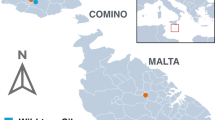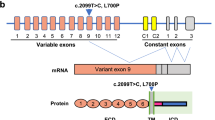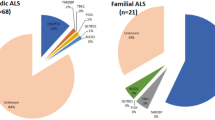Abstract
Amyotrophic lateral sclerosis (ALS) and primary lateral sclerosis (PLS) are neurodegenerative conditions that affect large motor neurons of the central nervous system. We have identified a familial juvenile PLS (JPLS) locus overlapping the previously identified ALS2 locus on chromosome 2q33. We report two deletion mutations in a new gene that are found both in individuals with ALS2 and those with JPLS, indicating that these conditions have a common genetic origin. The predicted sequence of the protein (alsin) may indicate a mechanism for motor-neuron degeneration, as it may include several cell-signaling motifs with known functions, including three associated with guanine-nucleotide exchange factors for GTPases (GEFs).
This is a preview of subscription content, access via your institution
Access options
Subscribe to this journal
Receive 12 print issues and online access
We are sorry, but there is no personal subscription option available for your country.
Buy this article
- Purchase on SpringerLink
- Instant access to full article PDF
Prices may be subject to local taxes which are calculated during checkout





Similar content being viewed by others
References
Pringle, C.E. et al. Primary lateral sclerosis: clinical features, neuropathology and diagnostic criteria. Brain 115, 495–520 (1992).
Charcot, J.M. Sclerose des cordons laeraux de la moelle epinière, chez une femme hystèrique, atteinte de contracture permanente des quatre members. Bull. Soc. Med. Hop. Paris 2, 24–42 (1965).
Erb, W.A. Über einen wenig bekannten spinalen symptomenkomplex. Berl. Klin. Wochenschr 12, 357–359 (1975).
Stark, F.M. & Moersch, F.P. Primary lateral sclerosis. J. Nerv. Ment. Dis. 102, 332–352 (1945).
El Escorial World Federation of Neurology criteria for the diagnosis of amyotrophic lateral sclerosis. J. Neurol. Sci. 124, 96–107 (1994).
Hudson, A.J. et al. Clinicopathological features of primary lateral sclerosis are different from amyotrophic lateral sclerosis. Brain Res. Bull. 30, 359–364 (1993).
Beal, M.F. & Richardson, E.P. Primary lateral sclerosis: a case report. Arch. Neurol. 38, 630–633 (1981).
Fisher, C.M. Pure spastic paralysis of corticospinal origin. Can. J. Neuro. Sci. 4, 251–258 (1977).
Russo, L.S. Jr. Clinical and electrophysiological studies in primary lateral sclerosis. Arch. Neurol. 39, 662–664 (1982).
Sotaniemi, K.A. & Myllylla, V.V. Primary lateral sclerosis, a debated entity. Acta Neurol. Scand. 71, 334–336 (1985).
Younger, D.S. et al. Primary lateral sclerosis: a clinical diagnosis reemerges. Arch. Neurol. 45, 1304–1307 (1988).
Gascon, G.G. et al. Familial childhood primary lateral sclerosis with associated gaze paresis. Neuorpediatrics 26, 313–319 (1995).
Heene, R., Kolander, D. & Knisatschek, H. Die chronisch-progrediente spinobulbäre spastik (primare lateralsklerose). Fortschr. Neurol. Psychiat. 64, 192–203 (1996).
Brown, W.F., Ebers, G.C., Hudson, A.J., Pringle, C.E. & Veitch, J. Motor evoked responses in primary lateral sclerosis. Muscle Nerve 15, 626–629 (1992).
Grunnet, M.L., Leicher, C., Zimmerman, A., Zalneraitis, E. & Barwick, M. Primary lateral sclerosis in a child. Neurology 39, 1530–1532 (1989).
Lerman-Sagie, T., Filliano, J., Smith, D.W. & Korson, M. Infantile onset of hereditary ascending spastic paralysis with bulbar involvement. J. Child. Neurol. 11, 54–57 (1996).
Siddique, T. et al. Linkage of a gene causing familial amyotrophic lateral sclerosis to chromosome 21 and evidence of genetic-locus heterogeneity. New Engl. J. Med. 324, 1381–1384 (1991).
Hentati, A. et al. Linkage of recessive familial amyotrophic lateral sclerosis to chromosome 2q33–q35. Nature Genet. 7, 425–428 (1994).
Hentati, A. et al. Linkage of a commoner form of recessive amyotrophic lateral sclerosis to chromosome 15q15-q22 markers. Neurogenetics 2, 55–60 (1998).
Chance, P. F. et al. Linkage of the gene for an autosomal dominant form of juvenile amyotrophic lateral sclerosis to chromosome 9q34. Am. J. Hum. Genet. 62, 633–640 (1998).
Rosen, D. R. et al. Mutations in Cu/Zn superoxide dismutase gene are associated with familial amyotrophic lateral sclerosis. Nature 362, 59–62 (1993).
Deng, H.-X. et al. Amyotrophic lateral sclerosis and structural defects in Cu,Zn superoxide dismutase. Science 261, 1047–1051 (1993).
Ben Hamida, M., Hentati, F. & Ben Hamida, C. Hereditary motor system diseases (chronic juvenile amyotrophic lateral sclerosis). Brain 113, 347–363 (1990).
Cottingham, R.W. Jr, Idury, R.M. & Schaffer, A.A. Faster sequential genetic linkage computations. Am. J. Hum. Genet. 53, 252–263 (1993).
Lathrop, G.M., Lalouel, J.M., Julier, C. & Ott, J. Strategies for multilocus linkage analysis in humans. Proc. Natl Acad. Sci. USA 81, 3443–3446 (1984).
Schaffer, A.A., Gupta, S.K., Shriram, K. & Cottingham, R.W. Jr. Avoiding recomputation in linkage analysis. Hum. Hered. 44, 225–237 (1994).
Ott, J. Analysis of Human Genetic Linkage revised edition 194–216 (Johns Hopkins University, Baltimore, 1991).
Deng, H.X. et al. Chromosome-band-specific painting: chromosome in situ suppression hybridization using PCR products from a microdissected chromosome band as a probe pool. Hum. Genet. 89, 13–17 (1992).
Sonnhammer, E.L.L., Eddy, S.R., Birney, E., Bateman, A. & Durbin, R. Pfam: multiple sequence alignments and HMM-profiles of protein domains. Nucleic Acids Res. 26, 320–322 (1998).
Delcher, A.L. Alignment of whole genomes. Nucleic Acids Res. 27, 2369–2376 (1999).
Schultz, J., Milpetz, F., Bork, P. & Ponting, C.P. SMART: identification and annotation of domains from signalling and extracellular protein sequences. Nucleic Acids Res. 27, 229–232 (1999).
Lemmon, M.A. and Ferguson, K.M. Signal-dependent membrane _targeting by pleckstrin homology (PH) domains. Biochem. J. 350, Pt 1: 1–18 (2000).
Takeshima, H. et al. Junctophilins: a novel family of junctional membrane complex proteins. Mol. Cell. 6, 11–22 (2000).
Lehman, A. et al. A very large protein with diverse functional motifs is deficient in rjs (runty, jerky, sterile) mice. Proc. Natl Acad. Sci. USA 95, 9436–9441 (1998).
Kahana, J.A. & Cleveland, D.W. Some importin news about spindle assembly. Science 291, 1718–1719 (2001).
Roepman, R. et al. Positional cloning of the gene for X-linked retinitis pigmentosa 3: homology with the guanine-nucleotide-exchange factor RCC1. Hum. Mol. Genet. 5, 1035–1041 (1996).
Yan, D. et al. Biochemical characterization and subcellular localization of the mouse retinitis pigmentosa GTPase regulator (mRpgr). J. Biol. Chem. 273, 19656–19663 (1998).
Rosa, J.L. & Casaroli-Marano, R.P. A giant protein that stimulates guanine nucleotide exchange on ARF1 and Rab proteins forms a cytosolic ternary complex with clathrin and Hsp70. Oncogene 15, 1–6 (1997).
Bar-Sagi, D. & Hall, A. Ras and Rho GTPases: a family reunion. Cell 103, 227–238 (2000).
Hama, H., Tall, G.G. & Horazdovsky, B.F. Vps9p is a guanine nucleotide exchange factor involved in vesicle-mediated vacuolar protein transport. J. Biol. Chem. 274, 15284–15291 (1999).
Rampoldi, L. et al. A conserved sorting-associated protein is mutant in chorea-acanthocytosis. Nature Genet. 28, 119–120 (2001).
Mourelatos, Z., Gonatas, N.K., Stieber, A., Gurney, M.E. & Dal Canto, M.C. The Golgi apparatus of spinal cord motor neurons in transgenic mice expressing mutant Cu,Zn superoxide dismutase becomes fragmented in early, preclinical stages of the disease. Proc. Natl Acad. Sci. USA 93, 5472–5477 (1996).
Gurney, M.E. et al. Motor neuron degeneration in mice that express a human Cu,Zn superoxide dismutase mutation. Science 264, 1172–1175 (1994).
Brown, R.H. SOD1 aggregates in ALS: cause, correlate or consequence? Nature Med. 4, 1362–1364 (1998).
Cleveland, D.W. From Charcot to SOD1: mechanisms of selective motor neuron death in ALS. Neuron 24, 515–520 (1999).
Deng, H.X. and Siddique, T. Transgenic mouse models and human neurodegenerative disorders. Arch. Neurol. 57, 1695–1702 (2000).
Atawater, J.A., Wisdom, R. & Verma, I.M. Regulated mRNA stability. Annu. Rev. Genet. 24, 519–541 (1990).
Shoshani, T. et al. Similar levels of mRNA from the W1282X and the DeltaF508 cystic fibrosis alleles, in nasal epithelial cells. J. Clin. Invest. 93, 1502–1507 (1994).
Haardt, M., Benharourga, M., Lechardeur, D., Kartner, N. & Lukacs, L. C-terminal truncations destabilize the cystic fibrosis transmembrane conductance regulator without impairing its biogenesis. J. Biol. Chem. 274, 21873–21877 (1999).
Dunnen, J.T. & Antonarakis, S.E. Mutation nomenclature extensions and suggestions to describe complex mutations: a discussion. Human Mutat. 15, 7–12 (2000).
Acknowledgements
We are deeply indebted to the members of the Tunisian and Saudi Arabian families for their participation. This study was funded by grants from the NIH (PO1 NS21442, RO1 NS37912 and RO1 NS40308), the Les Turner ALS Foundation, Grant Healthcare Foundation, the Michael Jordan Foundation and the Ralph and Marian Falk Medical Research Trust. K.O. is a Muscular Dystrophy Association funded fellow and W.-Y.H. is a Muriel Heller Fellow.
Author information
Authors and Affiliations
Corresponding author
Rights and permissions
About this article
Cite this article
Yang, Y., Hentati, A., Deng, HX. et al. The gene encoding alsin, a protein with three guanine-nucleotide exchange factor domains, is mutated in a form of recessive amyotrophic lateral sclerosis. Nat Genet 29, 160–165 (2001). https://doi.org/10.1038/ng1001-160
Received:
Accepted:
Issue Date:
DOI: https://doi.org/10.1038/ng1001-160
This article is cited by
-
Clinical features and molecular genetic investigation of infantile-onset ascending hereditary spastic paralysis (IAHSP) in two Chinese siblings caused by a novel splice site ALS2 variation
BMC Medical Genomics (2024)
-
Amyotrophic lateral sclerosis: translating genetic discoveries into therapies
Nature Reviews Genetics (2023)
-
Unraveling the Potential of EphA4: A Breakthrough _target and Beacon of Hope for Neurological Diseases
Cellular and Molecular Neurobiology (2023)
-
Modelling amyotrophic lateral sclerosis in rodents
Nature Reviews Neuroscience (2022)
-
Autophagy Dysfunction in ALS: from Transport to Protein Degradation
Journal of Molecular Neuroscience (2022)



